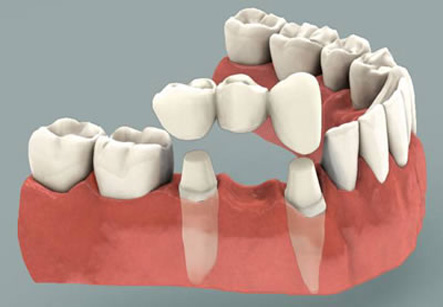Dental Bridges
Introduction
Dental bridges (also known as Fixed Partial Dentures) are literally bridges of prosthetic tooth or teeth that are used to fill in gaps between one or more missing teeth. Dental bridges are used to beautify or restore smiles, ability to speak or chew or bite adequately. They also help restore the shape of the face and prevent the misalignment of the remaining teeth.
Procedure Details
These are tooth crowns that are fixed within the existing anchoring teeth on either side called the abutment teeth. The false teeth are known as pontics. They are prosthetics that are made of metals like gold or alloys, porcelain or a combination of these or other materials.
The bridges last for 5 to 15 years and even longer at times with proper care and good oral hygiene.
The bridges may be of three basic types. A traditional or conventional bridge involves creating of a crown for an implant tooth between two existing teeth.
These are the commonest and are made of porcelain that is combined with metal or ceramics. A cantilever bridge type of bridge may be used when there are no teeth on one side of the missing tooth. The Maryland Bonded bridges are also used.
Iran offers a superior Dental treatments that is world best quality. For patients from the USA, and Europe for example, the savings can be 60% or more

These are resin-bonded bridges that may be made of plastic teeth and gums and supported by a metal framework. There are metal wings on either side of the bridge that are bonded with the existing teeth.
Before any of the bridges are chosen the teeth and their alignment is studied. Some amount of contouring of the existing teeth may also be needed to allow for the pontics. Thereafter an impression of the teeth is taken on a cast and the bridge or pontic is modeled on this cast by a dental laboratory.
Before the actual pontic is ready a temporary bridge is placed at the missing space to protect the exposed teeth and gums while the bridge is being made.
Recuperation and post operative complications
At a second visit the temporary bridge will be removed and the new permanent bridge will be checked and adjusted, as necessary, to achieve a proper fit. Further visits to check for fit of the metal frame, bite capacity and accuracy etc. may be necessary.
After a couple weeks, the bridge is permanently cemented into place.
The bridges last for 5 to 15 years and even longer at times with proper care and good oral hygiene. Regular checkups are needed to increase the life span of the bridges.
Regular brushing of teeth, flossing and generally preventing teeth and gum disease can help and so can selecting a healthy, nutritionally balanced diet.